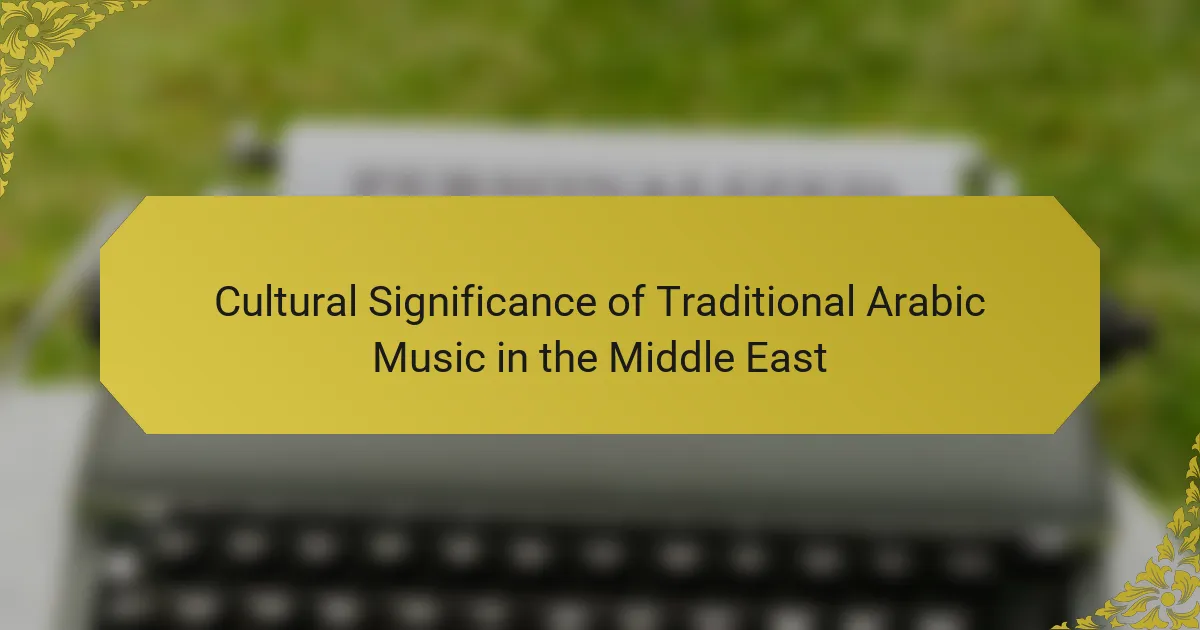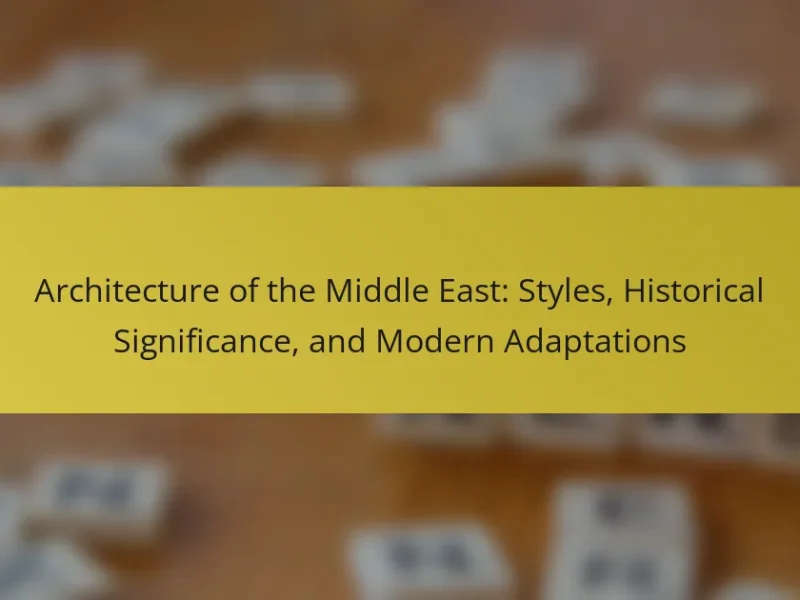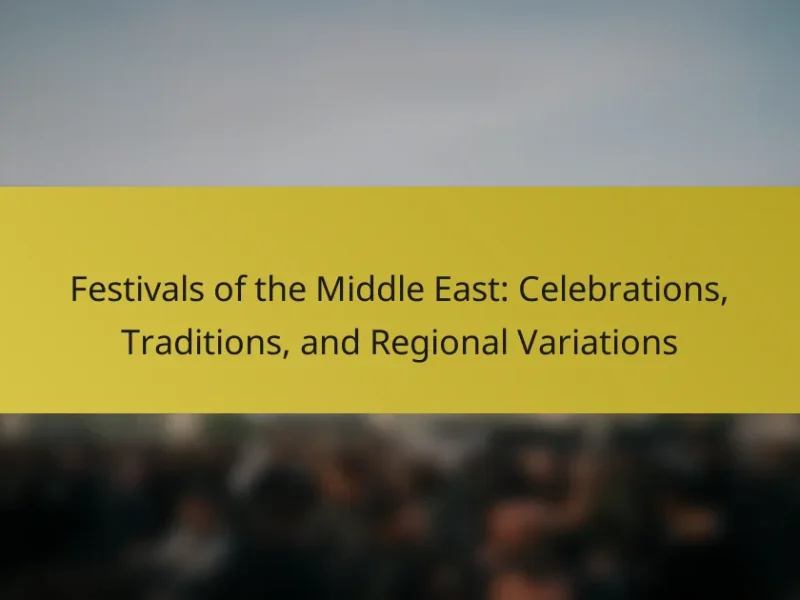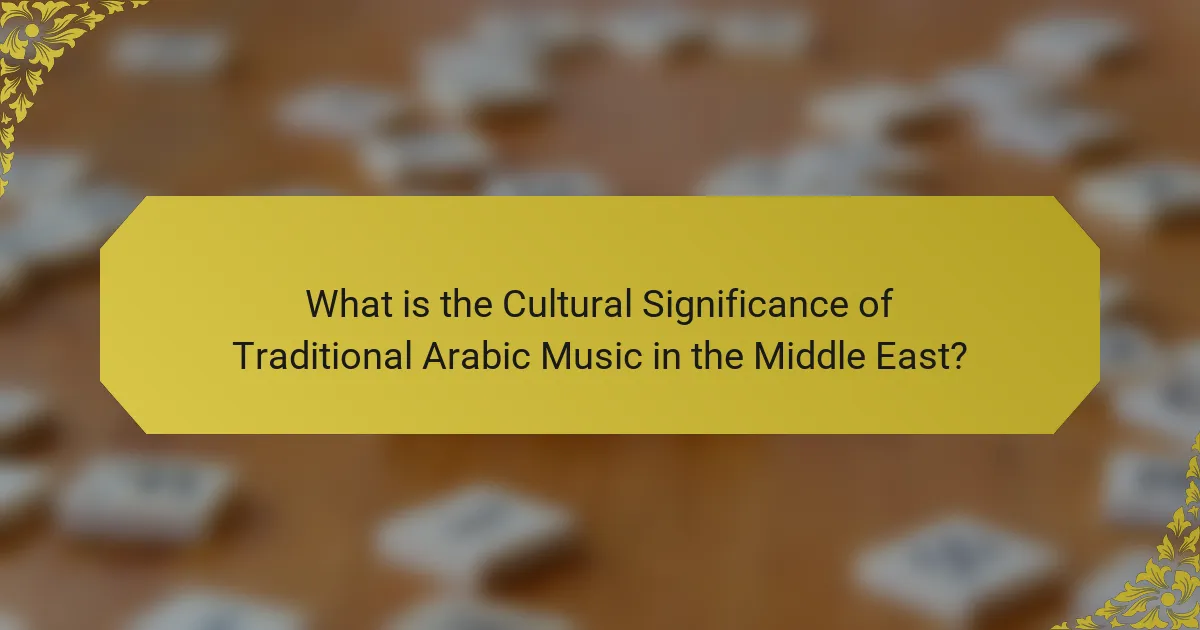
What is the Cultural Significance of Traditional Arabic Music in the Middle East?
Traditional Arabic music holds profound cultural significance in the Middle East. It serves as a vital expression of identity and heritage for various communities. This genre encompasses diverse styles, reflecting regional histories and social values. Traditional instruments like the oud and qanun are integral to its sound. Music is often used in celebrations, rituals, and storytelling, reinforcing communal bonds. Historical records indicate that Arabic music has influenced global music traditions for centuries. The UNESCO recognized Arabic music as part of the Intangible Cultural Heritage of Humanity. This acknowledgment highlights its importance in cultural preservation and education.
How has Traditional Arabic Music evolved over time?
Traditional Arabic music has evolved significantly over time, influenced by various cultural and historical factors. Its origins trace back to the 7th century with the establishment of the Islamic Golden Age. During this period, music was integrated into religious and social practices, shaping its early forms. The introduction of musical instruments like the oud and qanun contributed to its distinct sound.
In the 19th century, Western influences began to permeate Arabic music through colonial interactions. This led to the fusion of traditional melodies with Western harmonies and styles. The 20th century saw the rise of famous musicians, such as Umm Kulthum and Fairuz, who popularized Arabic music on a global scale.
Today, traditional Arabic music continues to evolve, incorporating modern genres and technology. The use of digital platforms has expanded its reach, allowing for new interpretations and collaborations. This ongoing evolution reflects the dynamic cultural landscape of the Middle East.
What historical events have influenced Traditional Arabic Music?
The historical events that have influenced Traditional Arabic Music include the spread of [censured] in the 7th century. This event facilitated cultural exchanges across the Arabian Peninsula and beyond. The Umayyad and Abbasid Caliphates further promoted music through patronage and the establishment of music schools. The Crusades introduced Western musical elements to the region. The Ottoman Empire’s expansion in the 15th century brought diverse musical traditions into Arabic music. Colonialism in the 19th and 20th centuries led to the fusion of local and Western styles. The rise of nationalism in the 20th century also shaped musical expressions, reflecting cultural identity. These events collectively contributed to the evolution and richness of Traditional Arabic Music.
How do different regions within the Middle East contribute to its evolution?
Different regions within the Middle East contribute to the evolution of traditional Arabic music through their unique cultural influences. Each region showcases distinct musical styles, instruments, and rhythms. For example, the Levant region is known for its maqam system, which defines melodic modes. North African countries incorporate Berber and Andalusian influences, enriching the musical landscape. The Arabian Peninsula emphasizes vocal traditions and poetry, reflecting Bedouin heritage. These regional characteristics lead to diverse musical expressions and innovations. Collaborative efforts among artists across regions further enhance the evolution of Arabic music. Historical trade routes facilitated the exchange of musical ideas, instruments, and practices. This interplay of cultural elements has resulted in a rich tapestry of traditional Arabic music that continues to evolve today.
Why is Traditional Arabic Music important to Middle Eastern identity?
Traditional Arabic music is crucial to Middle Eastern identity as it embodies cultural heritage and social values. This music reflects the diverse histories and traditions of various Middle Eastern communities. It serves as a means of storytelling, preserving oral histories and cultural narratives. Traditional Arabic music often features unique instruments like the oud and qanun, which are integral to its sound. Festivals and gatherings frequently include live performances, fostering community bonds. Furthermore, traditional music is a source of national pride, representing each country’s unique identity. Studies have shown that music plays a significant role in cultural expression and cohesion in the region. Overall, traditional Arabic music is a vital aspect of the Middle Eastern identity, connecting people to their roots and history.
What role does Traditional Arabic Music play in cultural celebrations?
Traditional Arabic music plays a central role in cultural celebrations. It enhances the festive atmosphere during events such as weddings, religious holidays, and community gatherings. Traditional instruments like the oud and darbuka create unique sounds that resonate with cultural identity. Music often accompanies traditional dances, fostering community participation and enjoyment. Lyrics typically reflect cultural stories and values, reinforcing social bonds. Research shows that music is integral to rituals, marking significant life events. The use of traditional music in celebrations strengthens cultural heritage and promotes continuity across generations.
How does Traditional Arabic Music reflect the values and beliefs of the communities?
Traditional Arabic music reflects the values and beliefs of communities through its themes and instruments. The music often embodies cultural identity, religious beliefs, and social values. For instance, many songs express themes of love, honor, and family, which are central to Arab culture. Instruments like the oud and qanun carry historical significance and are tied to regional traditions. The use of specific scales and rhythms can signify cultural heritage and community bonds. Additionally, traditional music is often performed during important rituals and celebrations, reinforcing shared beliefs. This connection to communal events highlights the role of music in preserving cultural narratives. Overall, traditional Arabic music serves as a powerful medium for expressing and maintaining the values and beliefs of the communities it represents.
What are the key characteristics of Traditional Arabic Music?
Traditional Arabic music is characterized by its unique scales, rhythms, and instruments. The music often utilizes the maqam system, which consists of specific scales that convey different emotions. Rhythmic patterns known as iqa’at create a distinct rhythmic structure. Instruments like the oud, qanun, and darbuka are commonly used, each contributing specific sounds. Vocal techniques, such as melisma, emphasize emotional expression. Traditional Arabic music often incorporates improvisation, allowing performers to showcase their creativity. The music serves as a cultural expression, reflecting the diverse heritage of the Arab world. Its characteristics have influenced various musical genres globally, highlighting its significance.
What instruments are commonly used in Traditional Arabic Music?
Traditional Arabic music commonly uses instruments such as the oud, qanun, and darbuka. The oud is a stringed instrument similar to a lute, known for its rich and warm sound. The qanun is a zither-like instrument played on the lap, featuring a distinctive, bright tone. The darbuka is a goblet drum that provides rhythmic accompaniment, often characterized by its sharp and resonant beats. These instruments are integral to the performance of traditional Arabic music, reflecting the cultural heritage of the Middle East. Their use can be traced back centuries, showcasing the deep-rooted musical traditions in the region.
How do scales and rhythms in Traditional Arabic Music differ from Western music?
Traditional Arabic music uses maqamat, which are microtonal scales, while Western music primarily uses diatonic scales. Maqamat allow for a wider range of pitches, creating unique melodic structures. In contrast, Western music typically adheres to a 12-tone equal temperament system.
Rhythms in Traditional Arabic music are often based on complex patterns called iqa’at. These patterns can include irregular time signatures and syncopation. Western music rhythms tend to follow more straightforward, regular patterns.
The use of improvisation is also significant in Arabic music, allowing musicians to express individuality within the framework of the maqamat and iqa’at. This contrasts with the more structured compositions often found in Western music.
How does Traditional Arabic Music influence contemporary music genres?
Traditional Arabic music significantly influences contemporary music genres by introducing unique scales, rhythms, and instruments. The maqam system, a modal framework in Arabic music, shapes melodies in genres like jazz and pop. Contemporary artists often incorporate Arabic scales to create distinctive sounds. Additionally, traditional rhythms, such as the 7/8 and 10/8 time signatures, are prevalent in modern fusion genres. Instruments like the oud and darbuka have been adopted in various musical styles worldwide. Collaborations between Arabic musicians and Western artists further blend these elements, enriching global music. Research indicates that this cross-cultural exchange enhances creativity and innovation in contemporary music.
What modern genres have been inspired by Traditional Arabic Music?
Modern genres inspired by Traditional Arabic Music include jazz, pop, and hip-hop. Artists often incorporate Arabic scales and rhythms into their music. For example, jazz musicians like Rabih Abou-Khalil blend traditional melodies with improvisation. In pop music, artists like Amr Diab fuse Western styles with Arabic sounds. Hip-hop artists also sample Arabic music to create unique beats. These genres showcase the global influence of Arabic musical traditions. The cross-cultural exchange enhances the richness of modern music.
How do fusion genres incorporate Traditional Arabic Music elements?
Fusion genres incorporate Traditional Arabic Music elements by blending its unique scales, rhythms, and instruments with other musical styles. For example, the maqam system, which is a set of scales used in Arabic music, is often integrated into Western pop and jazz. This incorporation creates a rich harmonic texture that enhances the overall sound. Additionally, instruments like the oud and darbuka are frequently used in fusion music, providing authentic Arabic timbres. The use of traditional Arabic vocal techniques can also be found in fusion genres, adding emotional depth to the music. Many contemporary artists, such as Omar Souleyman and Niyaz, exemplify this blending of styles. Their work showcases how traditional elements can coexist with modern genres, appealing to diverse audiences. This fusion not only preserves cultural heritage but also promotes cross-cultural dialogue.
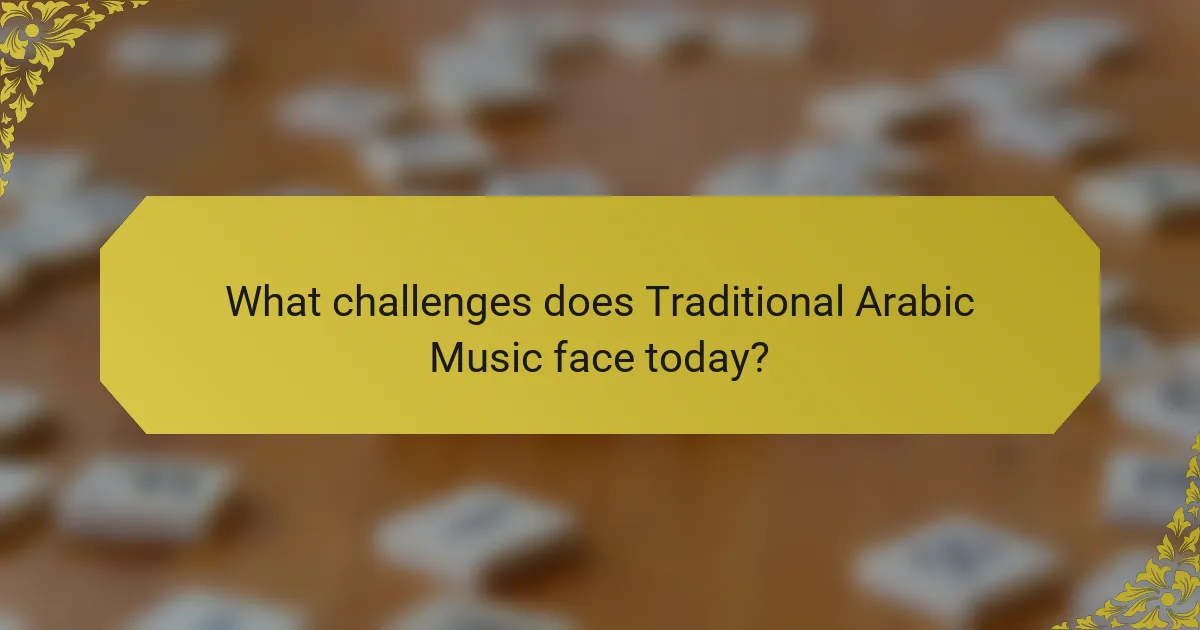
What challenges does Traditional Arabic Music face today?
Traditional Arabic music faces several challenges today. One significant challenge is the globalization of music. This has led to the overshadowing of traditional forms by popular genres. Young audiences often prefer Western music styles over traditional Arabic sounds. Additionally, there is a lack of institutional support for traditional music education. Many educational programs focus on contemporary music rather than preserving traditional practices. Another challenge is the commercialization of music. This can dilute the cultural authenticity of traditional Arabic music. Lastly, political instability in some regions affects cultural expression and preservation. These factors collectively threaten the survival and appreciation of traditional Arabic music.
How has globalization impacted Traditional Arabic Music?
Globalization has significantly impacted Traditional Arabic Music by facilitating cross-cultural exchanges. This has led to the fusion of traditional sounds with global music genres. Artists now blend Arabic music with pop, jazz, and electronic music. Increased access to technology has allowed for wider distribution of Arabic music worldwide. Platforms like YouTube and Spotify enable international audiences to discover and appreciate this genre. Additionally, collaborations between Arabic musicians and international artists have become more common. These collaborations often result in innovative musical styles that attract diverse listeners. The preservation of traditional elements remains crucial, even as new influences emerge.
What are the effects of digital media on Traditional Arabic Music preservation?
Digital media significantly impacts the preservation of Traditional Arabic Music. It facilitates wider access to music archives and recordings. Platforms like YouTube and Spotify enable global audiences to discover and appreciate this genre. Digital formats allow for the documentation of rare performances and regional styles. Additionally, social media promotes community engagement and sharing of musical heritage. This exposure can lead to increased interest and revitalization of traditional practices. Research indicates that digital archiving helps safeguard cultural expressions for future generations. The digitization of music enhances educational opportunities regarding Traditional Arabic Music.
How do cultural exchanges influence Traditional Arabic Music?
Cultural exchanges significantly influence Traditional Arabic Music by introducing new instruments, rhythms, and styles. These influences often stem from interactions with neighboring cultures and global music trends. For example, the incorporation of Western instruments like the guitar and piano has expanded the sound palette of Arabic music. Additionally, cross-cultural collaborations have led to innovative fusions, such as blending Arabic melodies with jazz or pop elements. Historical trade routes and migration patterns facilitated these exchanges, enriching the musical landscape. Festivals and cultural events also serve as platforms for sharing and evolving musical traditions. The ongoing dialogue between Arabic musicians and international artists continues to shape the genre. This dynamic interaction ensures that Traditional Arabic Music remains vibrant and relevant in a global context.
What efforts are being made to preserve Traditional Arabic Music?
Efforts to preserve Traditional Arabic Music include educational programs, cultural festivals, and digital archiving. Music schools and universities in the Middle East offer courses in traditional music. These institutions aim to teach younger generations about their musical heritage. Cultural festivals often showcase traditional music performances, attracting both local and international audiences. Digital archiving initiatives are underway to record and preserve traditional music. Projects like the Arab Digital Archive focus on collecting and digitizing historical recordings. These efforts ensure that traditional music remains accessible for future generations. Organizations such as the Arab Music Institute promote research and documentation of traditional music practices.
Which organizations are dedicated to the preservation of Traditional Arabic Music?
The organizations dedicated to the preservation of Traditional Arabic Music include the Arab Music Institute and the National Arab Orchestra. The Arab Music Institute focuses on research, education, and performance of Arabic music. It provides resources for musicians and scholars. The National Arab Orchestra promotes Arabic music through performances and educational programs. These organizations aim to sustain and revitalize traditional music forms. They also collaborate with artists and cultural institutions. Their efforts contribute to the cultural heritage of the Arab world.
How can individuals contribute to the preservation of Traditional Arabic Music?
Individuals can contribute to the preservation of Traditional Arabic Music by actively participating in its practice and promotion. Learning to play traditional instruments, such as the oud or qanun, helps keep the music alive. Attending cultural festivals and concerts supports artists and raises awareness of traditional forms. Sharing traditional music through social media platforms encourages wider appreciation. Documenting oral histories and performances preserves the cultural context of the music. Engaging in community workshops fosters intergenerational knowledge transfer. Supporting organizations dedicated to cultural preservation ensures resources for future generations. These actions collectively strengthen the cultural heritage of Traditional Arabic Music.
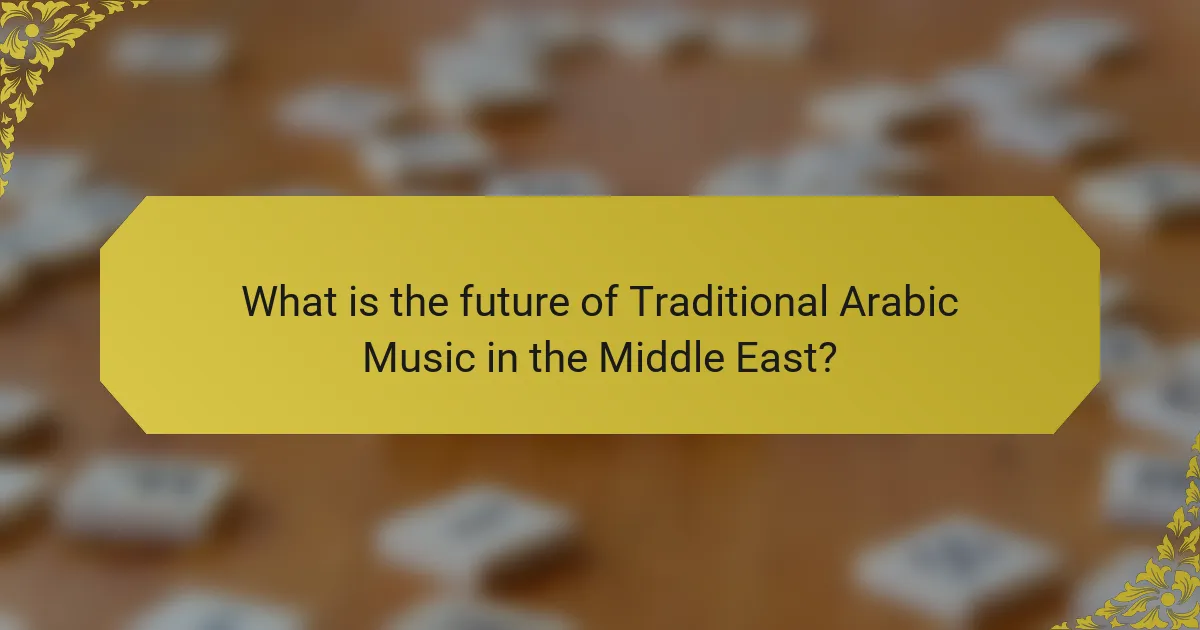
What is the future of Traditional Arabic Music in the Middle East?
The future of Traditional Arabic Music in the Middle East is likely to see a blend of preservation and innovation. As globalization influences musical trends, traditional forms may evolve while retaining their cultural essence. Artists are increasingly integrating modern genres with traditional sounds. This fusion appeals to younger audiences and fosters cross-cultural collaborations. Festivals and cultural initiatives are promoting traditional music, ensuring its visibility. Additionally, digital platforms are facilitating broader access to traditional music. These factors contribute to a dynamic future for Traditional Arabic Music in the region.
How can Traditional Arabic Music adapt to modern influences?
Traditional Arabic music can adapt to modern influences by incorporating contemporary genres and technologies. Musicians can blend traditional instruments with electronic sounds. Collaborations with artists from various genres can create fusion music. Utilizing social media platforms increases accessibility and audience reach. Engaging younger generations through educational programs can promote interest. Live performances can integrate multimedia elements for a modern experience. The rise of global music festivals allows traditional artists to showcase their work. These adaptations can maintain cultural relevance while appealing to modern audiences.
What role do younger generations play in the evolution of Traditional Arabic Music?
Younger generations play a crucial role in the evolution of Traditional Arabic Music. They are increasingly incorporating modern musical elements into traditional forms. This fusion creates new genres that attract wider audiences. Young musicians often use technology to produce and distribute their music. Platforms like social media allow them to share their work globally. They also engage in collaborations that blend various musical styles. These interactions help preserve traditional music while making it relevant to contemporary listeners. Research indicates that this generational shift revitalizes interest in cultural heritage.
What innovations are being introduced in Traditional Arabic Music performance?
Innovations in Traditional Arabic Music performance include the integration of modern technology and contemporary instruments. Artists are incorporating electronic elements to enhance soundscapes. The use of digital recording and mixing techniques allows for new auditory experiences. Collaborations with musicians from diverse genres are becoming common. This fusion creates unique styles that appeal to broader audiences. Live performances now often feature multimedia elements, such as visual art and lighting design. These innovations maintain traditional roots while attracting younger generations. The result is a revitalization of interest in Arabic music traditions.
What practical steps can be taken to support Traditional Arabic Music?
Promoting Traditional Arabic Music can be achieved through various practical steps. Organizing cultural festivals dedicated to Arabic music can raise awareness and appreciation. Providing funding for musicians and artists ensures they can continue their craft. Incorporating Arabic music into educational curricula helps teach the next generation. Establishing online platforms for streaming traditional music increases accessibility. Collaborating with international artists can introduce Arabic music to new audiences. Supporting local music venues gives traditional artists a space to perform. Encouraging community workshops fosters participation and learning in traditional music. These actions collectively contribute to the preservation and growth of Traditional Arabic Music.
How can communities engage with Traditional Arabic Music?
Communities can engage with Traditional Arabic Music through various methods. They can organize cultural festivals that showcase live performances. Workshops can be held to teach traditional instruments and vocal techniques. Schools can incorporate Arabic music into their curriculum to educate students. Local artists can collaborate with musicians to create fusion genres. Social media platforms can be used to promote events and share music. Community centers can host regular jam sessions for musicians and enthusiasts. These activities foster appreciation and understanding of the music’s cultural significance. Engaging with Traditional Arabic Music strengthens community bonds and preserves cultural heritage.
What resources are available for learning about Traditional Arabic Music?
Books, online courses, and music schools are valuable resources for learning about Traditional Arabic Music. Notable books include “The Music of the Arabs” by Habib Hassan Touma, which provides historical context and theory. Online platforms like Coursera and Udemy offer courses that cover various aspects of Arabic music theory and performance. Additionally, institutions such as the Arabic Music Institute in Cairo provide structured programs and workshops. YouTube channels dedicated to Arabic music also offer tutorials and performances, making learning accessible. These resources collectively enhance understanding and appreciation of Traditional Arabic Music.
Traditional Arabic music is an essential cultural entity in the Middle East, embodying the identity and heritage of various communities. This article explores its cultural significance, evolution over time, and the historical influences shaping its development. Key characteristics include unique scales, rhythms, and traditional instruments like the oud and qanun, which contribute to its distinct sound. The article also examines the role of traditional music in cultural celebrations, its impact on contemporary genres, and the challenges it faces in the modern world, alongside efforts for its preservation and adaptation to new influences.
